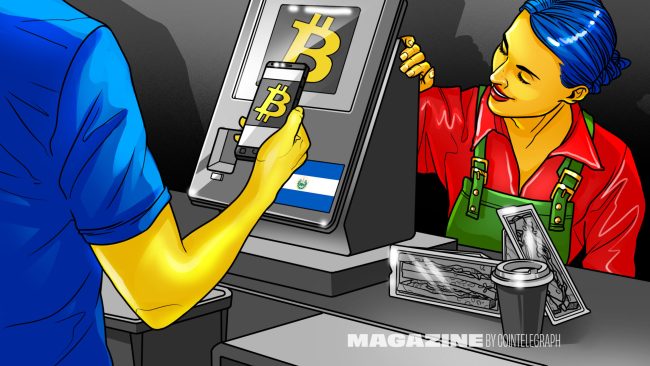I attempted to spend two weeks travelling in El Salvador living on Bitcoin. I tried to pay for every single thing with Bitcoin, or Satoshis, small amounts of Bitcoin. Spoiler alert, I failed.
Outfoxed by car hire companies (fortunately my car of choice was not Fiat); stubborn restauranteurs, a parking meter, pupusas, and a fancy dress shop where I was obliged to purchase a multicoloured wig with a $5 bill, I could not survive in “Bitcoin Country” on Bitcoin alone.
So where did I go wrong? How did this happen? Isn’t El Salvador supposed to be Bitcoin Country? Is Bitcoin broken? Am I a scammer?
First up, there’s no denying: El Salvador is unashamedly a Bitcoin destination. From Bitcoin conferences, big name Bitcoiners, ubiquitous “Bitcoin accepted here” signs, a laser eyed President and oodles of Bitcoin investments streaming into the country like transactions into the Bitcoin mempool, the nation is the first and greatest sign of Bitcoin adoption worldwide.
Moreover, let’s not forget the motivations behind the the “Ley Bitcoin,” or Bitcoin Law, voted in on June 8th 2021. In a statement, El Salvador’s National Assembly, shareed:
“With the aim of generating employment opportunities, promoting true financial inclusion and generating economic dynamism, the deputies of the Legislative Assembly approved the Bitcoin Law.”
Considering the law’s three goals, it’s mission accomplished. El Salvador’s GDP is hockeysticking higher; job creation has ticked up; tourism soared over 30% just this year and figures for the government supported Bitcoin wallet, Chivo, would suggest that the country is banking the unbanked.
In addition, I have plenty of personal anecdotes of friends and Bitcoin people who emigrated to El Salvador, established businesses in El Salvador, or simply visited the country for the first time–when never in a hundred years would El Salavdor feature on their bucket list holiday destinations prior to Bitcoin. But when it comes to paying in Bitcoin, it’s tough.
Bitcoin was mapped out as a “peer-to-peer cash electronic cash system,” the first line of the Bitcoin White Paper states. 14 years on, and one year after El Salvador announced Bitcoin as legal tender for payments, it’s not quite there.
Upon closer observation of the Bitcoin Law, it becomes clear that Bitcoin as a medium of exchange is not the priority. Under article 7, the law states: “Every economic agent must accept bitcoin as a form of payment when it is offered by someone who purchases a good or service.” However, it doesn’t say how to do so, what to do with Bitcoin earned or why they should HODL or spend Bitcoin… For me personally, what on earth should Salvadoreans on the ground should say to me when can I arrive at the counter and say “Puedo pagar con Bitcoin?” (Can I pay with Bitcoin).
As a result, and unsurprisingly, my experience using Bitcoin varies wildly. From Bitcoin maximalist coffee shops running Lightning full nodes to cash-in-hand street merchants on volcano trails who literally cannot access the internet, El Salvador has certainly put a spell on “magic internet money”. I hope this article sheds light on the experience of paying in Bitcoin across the country: an investigative report, light-hearted entertainment, and maybe a handy guide for your trip to spend Satoshis in Bitcoin Country.
Know what you’re doing; Focus
The Lightning Network–the layer-2 payments network built atop Bitcoin–is fast, secure, and near free to use. It blows away Mastercard, Visa and any other legacy payment rail in terms of cost and efficiency. Personally, I believe it’s only a matter of time before retail, and in particular, micropayments, upgrade to the Lightning Network. Remittance payments are the first movers–as we’ve seen with Strike and CoinCorner’s moves into Africa–but retail is catching on. Once you see it in action, it’s hard to put the toothpaste back into the tube.
Nonetheless, the user experience (UX) of Bitcoin applications and wallets using the LN require some rehearsal. Over the two weeks in El Salvador, I made several mistakes scanning QR codes, interacting with waiters, tipping people and trying to live on a Bitcoin Standard.
Plus, I discovered new UX traits specific to emerging countries. Did you know that dark mode as a default in applications is awful for hot, tropical countries? In a field under baking sun, with dust and dirt in my eye, dark mode is like wearing a blindfold. Looking at you, Strike. Or, did you know that cracked phones screens make it harder to scan QR codes? This happened a few times during my trip.
Read also
Features
The Becoming of Bitcoin: A Narrative Untainted by Illusions of Truth
…
cointelegraph.com
